Revival of airships. Airships as an important part of the armed forces of the XXI century
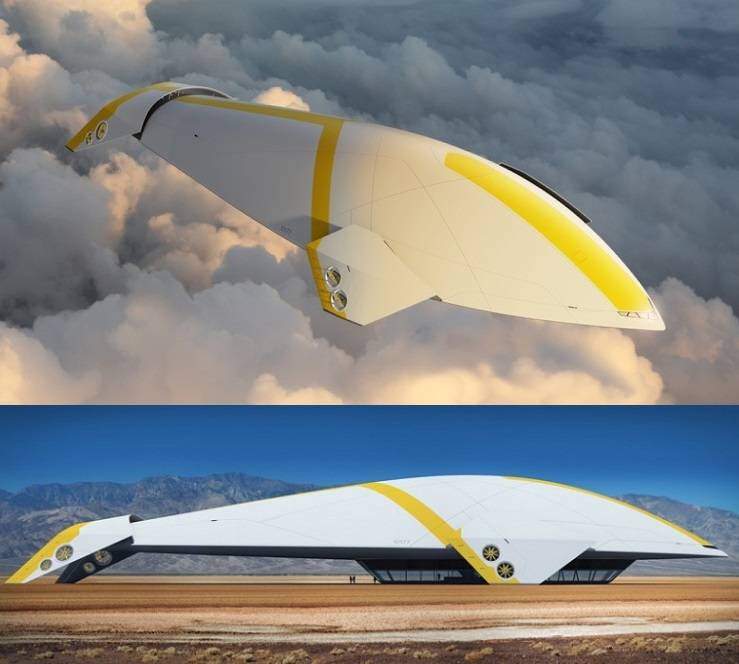
История вопроса
It is believed that the airship, controlled by muscular strength, was invented in the XVIII century by the French mathematician and divisional general Jean Baptiste Marie Charles Meunier. Airships developed half a century later when steam, and then electric motors, internal combustion engines appeared. The development of airships reached its peak in the period between the two world wars, when airship giants appeared, such as the “Graf Zeppelin” model, capable of carrying up to 25 tons of cargo over a distance of more than 10 000 km.
The airship "Hindenburg", capable of transporting loads of 100 tons, possessed even greater capabilities. Unfortunately, it was the disaster that occurred on 6 on May 1937 of the year with the Hindenburg that marked the end of the dirigible era.

The main problem of the airships of that time was that their tanks were filled with explosive hydrogen. Taking into account the fact that it is impossible to guarantee the absence of leakage of such a volatile and combustible substance throughout its service life, the disaster was predetermined.
Technically, non-combustible helium was already produced in 1937, however, only the United States, which refused to ship it to Germany, which produced the largest airships, could produce it on an industrial scale. There are conspiracy theories that airship accidents were the result of competition with aircraft manufacturers. However, it seems most likely that a big war loomed on the horizon, with all the advantages of airships, their “combat” capabilities were significantly inferior to the capabilities of airplanes, which predetermined the latter’s primary development. It was hardly justifiable to invest heavily in obtaining expensive (even now) helium in the conditions of pre-war time.
Return to the airships. Western projects
Nevertheless, story spirals, and in the 21st century there is a certain interest in the revival of the construction of airships at a new technological level. Development companies and the Air Force are considering several areas of construction of promising airships. Firstly, these are airships designed to accommodate means of reconnaissance and communications, and secondly, these are transport giant airships capable of carrying hundreds of tons of cargo over great distances.
In 2005, the well-known agency of advanced defense research projects DARPA announced the opening of the program to build the Walrus super-heavy transport airship with a payload from 500 to 1000 tons and a range to 22 thousands of kilometers.
As part of the super-heavy airship program, the aforementioned DARPA agency issued a grant to 3 of a million US dollars to Lockheed Martin. Lockheed Martin's subcontractor, Worldwide Aeros Corp, proposed the design of the Aeroscraft airship. The company Worldwide Aeros Corp planned to build the Aeroscraft airship in three versions, the model ML866 with a loading capacity of 66 tons, the model ML868 with a loading capacity of 250 tons and the model ML86X with a loading capacity of 500 tons.
Unfortunately, they managed to create only a Dragon Dream airship prototype with a length of 81 meters and a volume of 17 thousands of cubic meters. In 2015, a part of the roof of the hangar collapsed, in which the prototype of the Dragon Dream was based, which led to its destruction and collapse of work. By the way, Worldwide Aeros Corp was founded in 1992 by the current CEO and Chief Engineer Igor Pasternak, who came to America from Ukraine after the collapse of the USSR.
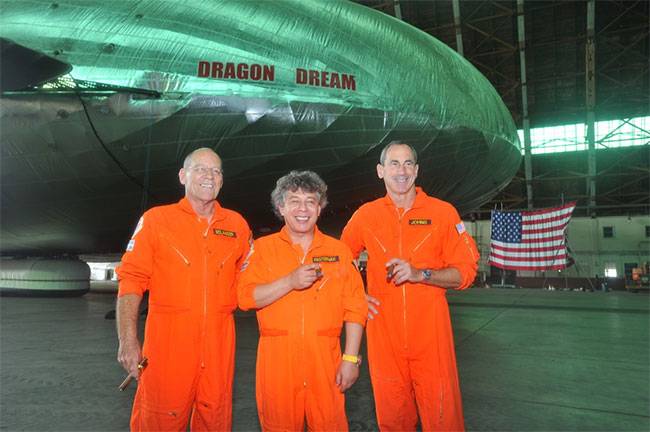
The first flight of the Dragon Dream airship
Obviously, the creation of airships carrying capacity of 500-1000 tons will require the solution of a huge number of complex technical problems. Given that the airship industry has been in oblivion for quite a long time, on the way to the creation of super-large-capacity airships, smaller-capacity samples should be built in stages.
One of the projects implemented is the Airlander 10 airship designed and manufactured by the British company Hybrid Air Vehicles. The airship “Airlander 10” is a hybrid one — it uses aerodynamic lift when lifting and then is airborne due to the volume filled with helium. Its length is 92 meter, payload ten tons. The cruise altitude of the airship is 6 100 m, cruising speed 148 km / h. He can be in flight up to two weeks in unmanned mode and about five days with the crew.
Initially, the airship was designed for the US Army under the LEMV program for conducting reconnaissance and surveillance in the interests of the ground forces. However, in 2013, the US Army abandoned this airship, presumably because of its high cost. In the future, the project developed as a commercial, updated version of the airship made several flights, but in 2017, the Airlander 10 airship broke away from the mooring mast and was completely destroyed as a result of hitting the take-off field.
First flight of the Airlander 10 hybrid airship
The American company JP Aerosapce is developing the Ascender stratospheric airship, designed to launch space launch vehicles, from a height of about 50-60 kilometers. Despite the fact that the concept itself raises many questions, the obtained results can be used to create airships with more realistic application scenarios, for example, used as communication repeaters or carriers of high-altitude reconnaissance vehicles.
From the height of 50-60 kilometers, the visibility range will be almost 1000 km, which will allow reconnaissance in the depth of the enemy’s territory without violating its borders. These heights are quite reachable for devices lighter than air — in 2009, the BU60-1 research unmanned ball, developed by the Aerospace Exploration Agency of Japan, rose to a height of 53 kilometers.
Airship building in Russia
In Russia, the main creator of the airships is the Avgur-RosAeroSystems holding. In June, 2015 of the year, the president of the holding company, Gennady Verba, announced that the company plans to build the Atlant airship by the end of 2018. The estimated cost of the project was several billion rubles. The family of airships "Atlant" should include three versions with a carrying capacity of 16, 60 and 170 tons, capable of operating at altitudes up to 10 thousands of meters. The military use of Atlant airships suggested their use as elements of a missile attack warning system. Vladimir Mikheev, Advisor to the First Deputy General Director of the Radioelectronic Technologies Concern (KRET), confirmed the information on the creation of the airship in the interests of the needs of antimissile defense in July 2015 of the year.
Presentation of the promising Russian airship "Atlant"
Another promising unmanned airship, the Golden Eagle, should be able to climb a kilometer 20-23 and stay in the air for up to six months. Longer flight duration must be ensured due to the absence of crew (unmanned airship) and the power supply system from solar panels. The main intended tasks of the airship "Berkut" - providing communication retransmission and altitude intelligence.
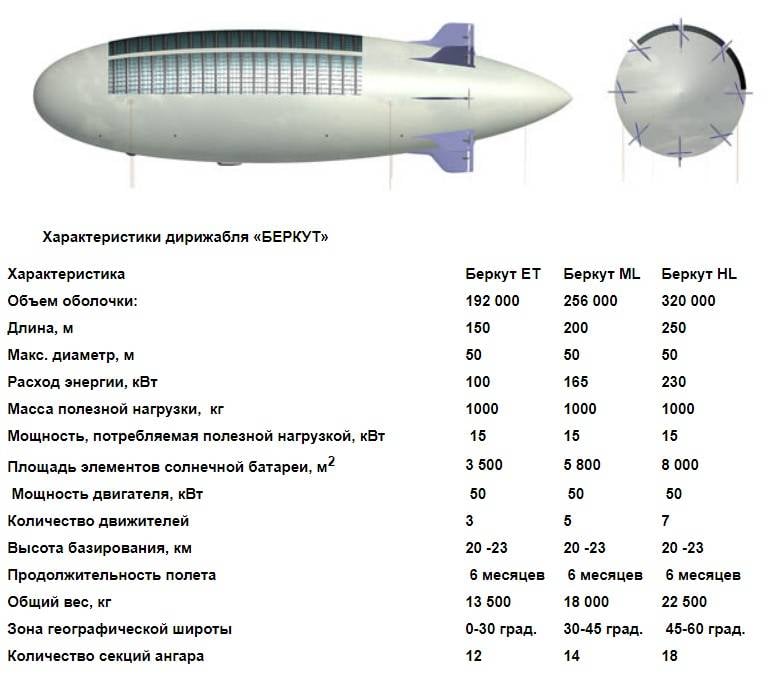
Airships are a rather vulnerable platform in the event of a conflict with a high-tech adversary due to their huge size and low airspeed, which, however, does not diminish their role as a means of warning of an attack using low-flying air attack weapons (EAS). Any large stationary objects, for example, such as radar stations of a missile attack warning station, can be considered easily vulnerable targets, which is no reason to abandon them.
If the development of airships with a carrying capacity of 500-1000 tons is successfully implemented, they can also become an essential element of the logistic system of the modern armed forces, combining the advantages of transport aircraft, helicopters and ships. In this case, the platform's vulnerability can be compensated by choosing the optimal flight routes to avoid colliding with the enemy forces.
Airships in local conflicts
It can be assumed that airships can play a crucial role in local conflicts against an adversary that does not have modern air defense systems.
One of the global problems of modern air forces is the high cost of not only airplanes and helicopters, but also the high cost of their operation.

As a result, local wars against militants, the most modern weapons of which can be anti-tank guided missiles (ATGMs) and man-portable air defense systems (MANPADS), become financially unbearable even for superpowers, as evidenced by the experience of the USSR and the USA in Afghanistan. There is no doubt that the costs of aviation the support of the Syrian government forces also flies to Russia in a penny.
How can the use of airships affect the situation? In the material Combat "Gremlins" US Air Force: the revival of the concept of aircraft carrier aircraft considered the concept of the US Air Force for the construction of advanced aircraft carriers - carriers of unmanned aerial vehicles (UAVs). According to DARPA agency projects, the placement of low-cost, reusable UAVs on board transport planes, bombers and tactical planes will reduce the likelihood of losses and simplify the enemy's air defense breakthrough. It can be assumed that this concept is also justified in terms of reducing the cost of conducting air / air combat.
However, in the fight against irregular formations, even the use of airborne aircraft carriers based on transport aircraft and bombers would be very expensive. As discussed in the same material, the first air carriers were just airships.
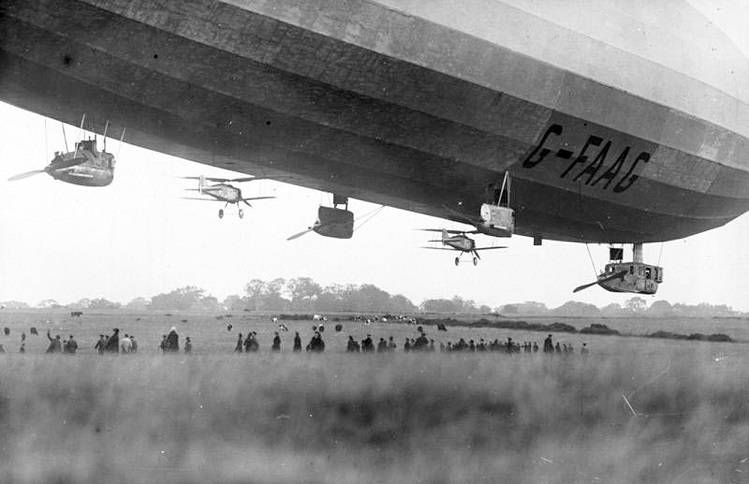
The concept of the airship-aircraft carrier may well be recreated at the modern technological level to solve problems in local conflicts.
Presumably, the creation of an Atlant-type airship with a payload of 60 tons and an altitude of more than 5000 meters will make it possible to develop a carrier airship on its base accommodating several types of small and medium-sized UAVs, as well as fuel and armament for them using 2-4 autonomous use weeks. The design of the UAV should be as simple as possible to reduce their cost.
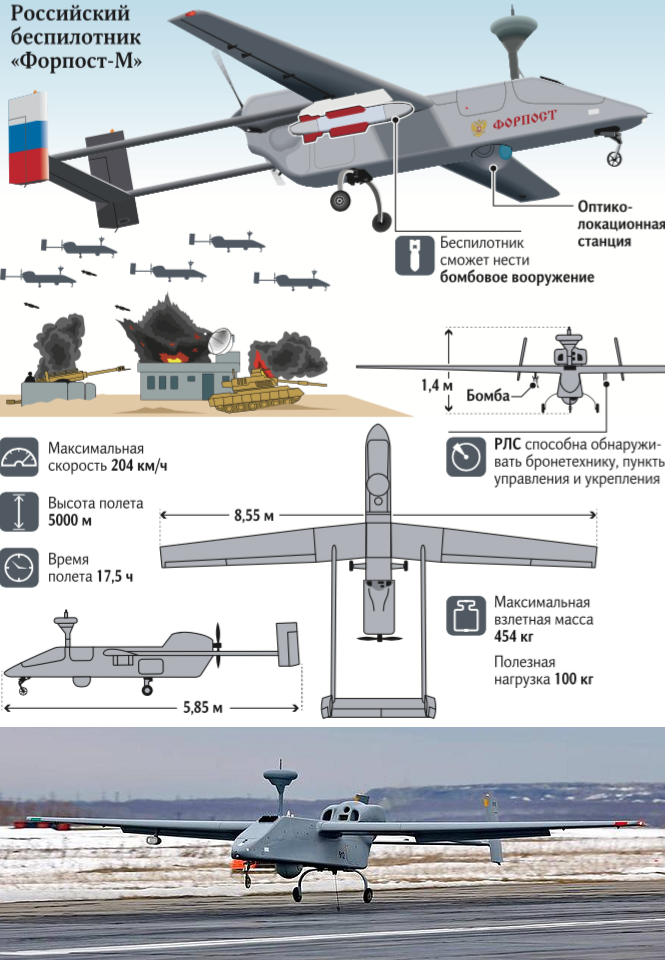
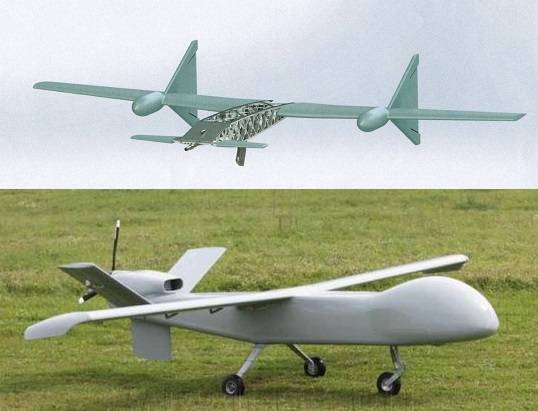
The number of UAVs on board may vary depending on their weight and size characteristics. For Forpost-M type UAVs, it is possible to consider as optimal the number of the order of 12-16 UAVs, in order to ensure that the UAV 3-4 in the three-shift version or the 6-8 in the two-shift mode can be around the clock. UAV control operators, the number of which is determined in accordance with the number of UAVs and work shifts, should also be placed on board the dirigible carrier.
UAV dirigible carrier application scenario
For example, in the course of a local conflict, it is necessary to seize control of a city that has become a stronghold of militants and demanding significant forces to be captured by government troops. Direct assault can lead to large losses among personnel, the use of combat aircraft and helicopters requires significant financial resources. In addition, modern fighters are ill-suited to defeat scattered militant groups, and Su-25-type attack and attack helicopters are vulnerable to enemy fire.
The dirigible carrier takes a given position above the city (or aside, at a short distance). The altitude above five kilometers makes it invulnerable to the air defense weapons available to the militants. In addition, it can be equipped with a means of countering attacks of MANPADS, such as "President-C".
Presentation of the system "President-C"
After entering the airship position, the UAV launches for patrolling. Patrol UAVs should be equipped with weapons with a minimum cost - guided and unguided small diameter bombs, unguided aircraft rockets, small arms and grenade launchers, etc. Detection of the enemy is conducted both by the means of reconnaissance of the UAV and by the means of reconnaissance of the dirigible carrier, which, after detecting the target, directs the closest UAV to it. The airship carrier is on duty for two weeks, after which it is replaced by another carrier airship.
The main task of the airship carrier and its wing is to carry out a constant, round-the-clock, exhausting effect on the enemy. Any target detected must be destroyed as soon as possible. Radar and thermal imaging intelligence should provide round-the-clock detection of the enemy, and finding the dirigible carrier near the area of responsibility will provide the minimum response time.
After several weeks of continuous exposure, it can be expected that the enemy will be significantly demoralized and will suffer heavy losses in manpower and weapons. In the event that a decision is made on ground-based storming, the UAVs from the carrier airship should provide direct air support to the ground forces. Given the specifics of the tasks performed, the UAV airship carrier should not be part of the Air Force, but part of the ground forces, acting directly in their interests, which will allow achieving the maximum level of interaction between the UAV operators and ground fighters.
Alternative placement of a UAV on a ground base will require either attracting models with a greater range of flight, and, therefore, with a higher flight cost, or equipment of the base near the zone of responsibility, and its defense. In any case, the reaction time will be increased and the possibility of detecting the enemy will be reduced.
As we saw in the table above, the cost of flying a Predator medium-sized UAV is about 4000 dollars, the cost of flying a small dimension UAV should be comparable to or lower than the cost of flying an OV-10 Bronco attack aircraft (1000 dollars) from the same table. The combination of the low cost of the flight of the UAV and the low cost of operating the airship, which is usually presented by their creators as an advantage of this type of aircraft, will significantly reduce the total cost of aviation support in local conflicts. The loss of a small dimension UAV is also much less sensitive than the loss of a medium dimension UAV, not to mention the loss of manned aircraft and helicopters.
In peacetime, carrier airships can be used to control extended sections of the state border of Russia, ensuring the detection and, if necessary, destruction of smugglers, militants or terrorist groups. For example, the control zone of a carrier airship with a Forpost-M type UAV can make up a circle with a diameter of 300-400 km.
Hack and predictor Aviator
The history of airships did not end with the tragedy of the Hindenburg. New technical solutions, new challenges and challenges can help the heavenly giants to find their niche in the sky. The most promising areas for the development of airships can be considered the provision of reconnaissance and retransmission of communications, as well as the delivery of massive bulky cargo over long distances with the possibility of working on unequipped sites. A separate direction of airship development can be the creation of UAV airship carriers for use in local conflicts against an adversary that is not equipped with modern air defense systems.
- Andrey Mitrofanov
- popmech.ru, rosaerosystems.ru, army-news.ru, novate.ru, topwar.ru
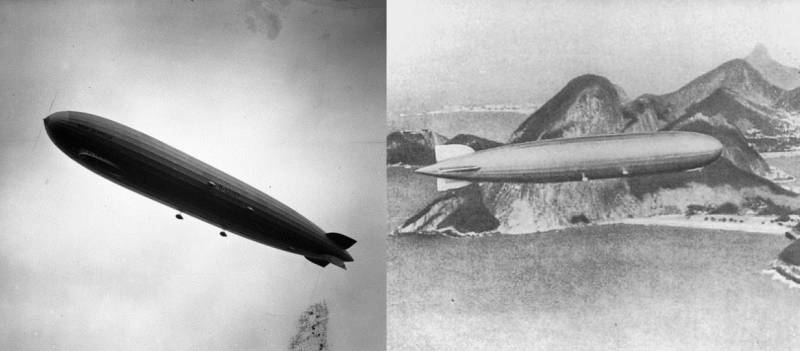

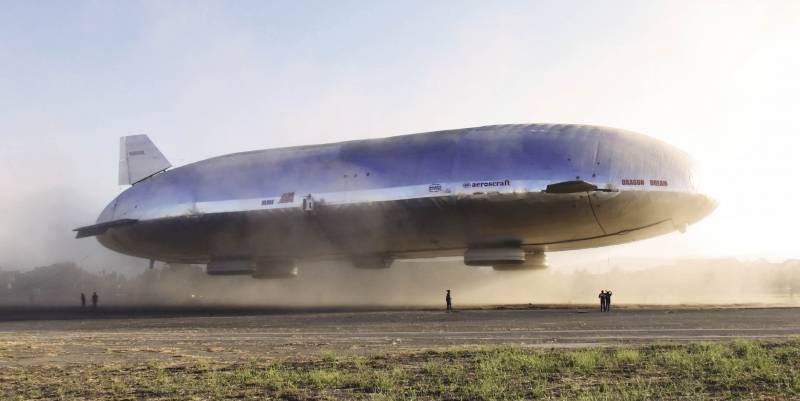
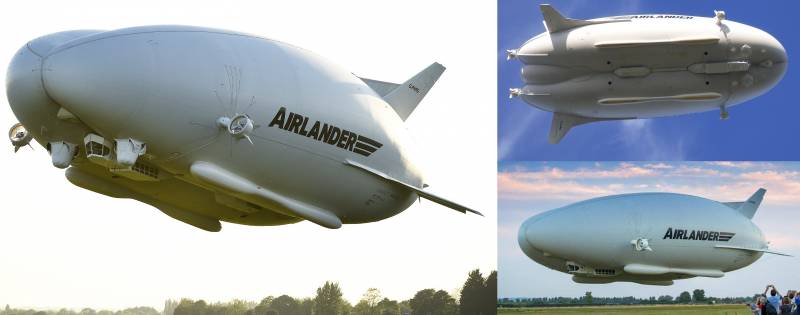
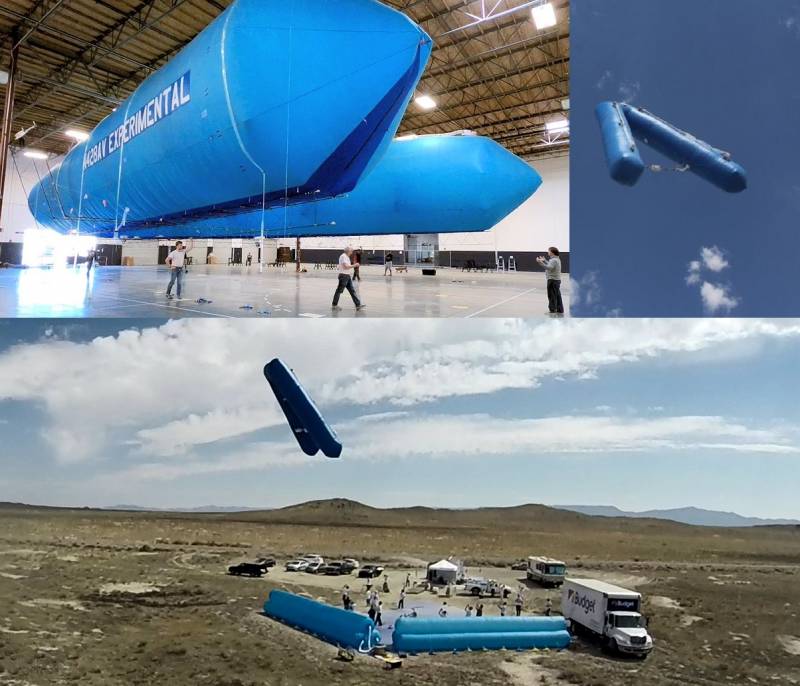
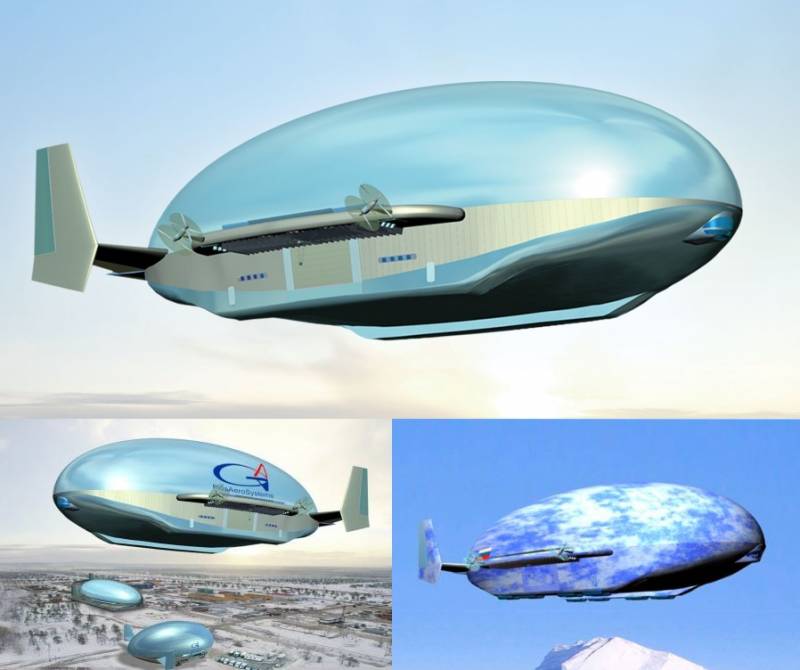
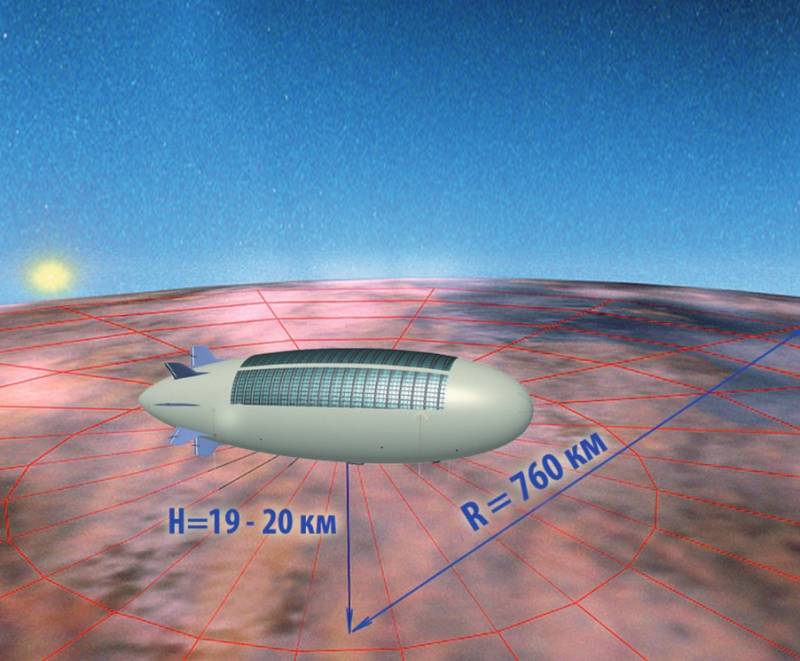
Information